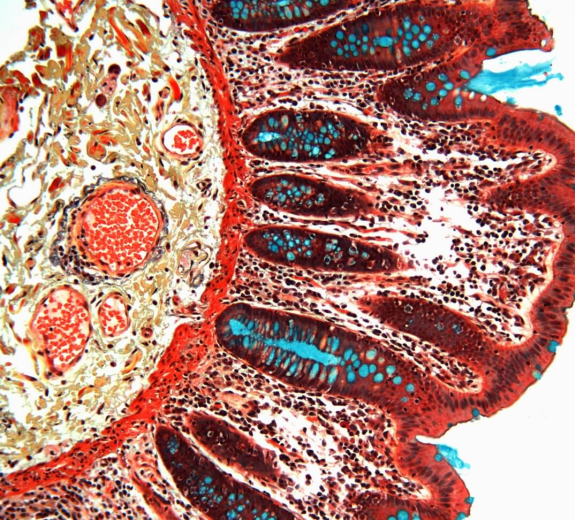
New Biorepository Studies Celiac Disease
Celiac disease can be difficult to diagnose and has no cure. Benaroya Research Institute at Virginia Mason (BRI) recently launched a new biorepository for the disease to collect blood samples, tissue samples and medical histories of people with the disease. This will allow scientists to study the disease and research novel approaches to the diagnosis and treatment of celiac disease, says Elisa Boden, MD, clinical researcher at BRI who is establishing the Celiac Disease Biorepository. Dr. Boden is also a gastroenterologist at the Digestive Disease Institute at Virginia Mason Medical Center.
Celiac disease occurs when the immune system attacks the small intestine after exposure to gluten (a protein found in wheat, rye and barley). This causes inflammation and damage to the small intestine, which can prevent the absorption of water and nutrients into the body. Celiac disease is also known as coeliac disease, celiac sprue, non-tropical sprue, and gluten sensitive enteropathy. Celiac disease is hereditary, meaning that it runs in families. About 1 in 10 people with a first-degree relative with celiac disease (parent, child, sibling) will develop celiac disease.
Celiac disease is estimated to affect 1 in 100 people in the United States and its incidence appears to be rising. In addition, 2.5 million Americans are undiagnosed and may be at risk for long-term health complications. Celiac disease can develop at any age, affecting both children and adults. Left untreated, celiac disease can lead to additional serious health problems. These include nutritional deficiencies, anemia, increased risk of infections, osteoporosis, dermatitis herpetiformis (an itchy skin rash), infertility or miscarriage, neurological conditions including seizures and migraines, and intestinal cancers.
Gluten Free Diet
Currently, the only treatment for celiac disease is lifelong adherence to a strict gluten-free diet. People living gluten-free must avoid foods with wheat, rye and barley, found in many foods including bread, pasta and beer. Gluten is additionally used commonly as a filler in many processed foods. With the increased marketing and development of gluten-free foods, a gluten-free diet has become easier to follow. However, many people with celiac disease still find the diet restrictive and difficult to follow, especially when eating outside their home. In addition, the majority of people with celiac disease continue to demonstrate evidence of ongoing intestinal damage even while attempting to adhere to a strict gluten-free diet. Thus, there is a clear need for adjunctive therapies in the treatment of celiac disease.
There are additionally some people who may have “gluten intolerance” without having celiac disease. These patients may experience symptoms of abdominal pain, bloating, diarrhea or fatigue when they eat a diet containing gluten. While these are common symptoms of celiac disease, these individuals do not have the characteristic small intestinal damage or tissue transglutaminase (tTG) antibodies found in celiac disease. “We do not yet clearly understand what causes non-celiac gluten intolerance,” says Dr. Boden. “Some experts have suggested that many symptoms attributed to gluten intolerance may be caused by FODMAP (fructose, olygosaccharides, disaccharides, monosaccharides and polyols)-containing foods that are largely eliminated in gluten-free diets.
“Celiac disease is restricted to people with certain HLA class II genes,” she explains. “About 40 percent of people have these genes but only 1 percent get the disease. This tells us there are other important genetic or environmental factors that play into the immune reaction in celiac disease. By studying people with celiac disease and healthy people with the same genes, we hope to discover both factors that trigger disease and also those that protect healthy people. We will use this information to develop ways to put the brakes on the immune system to stop it from reacting to gluten. Our hope is to find ways to eliminate the devastating symptoms of this disease and stop damage to the small intestine.”
Symptoms Of Celiac Disease
Celiac disease can be difficult to diagnose because it may affect many organ systems outside the intestines. Some people with celiac disease have no symptoms. However, all people with celiac disease are at risk for long-term complications, whether or not they display any symptoms.
Does Your Child Have Celiac Disease?
Digestive symptoms are more common in infants and children. Some of the most common symptoms found in children include abdominal pain and bloating, chronic diarrhea, vomiting, constipation, irritability and behavior issues, weight loss, fatigue and delayed growth.
Do You Have Celiac Disease?
Adults are less likely to have digestive symptoms, with only one-third experiencing diarrhea. Adults are more likely to have symptoms such as unexplained iron deficiency, fatigue, bone or joint pain, arthritis, bone loss, depression or anxiety, tingling in hands and feet, seizures, migraines, infertility, canker sores and rashes. For more information, visit the celiac disease disease information page.
Joining The Celiac Disease Biorepository
If you are interested in joining or learning more, visit the Gastrointestinal Disease Biorepository.
Immuno-what? Hear the latest from BRI
Keep up to date on our latest research, new clinical trials and exciting publications.


